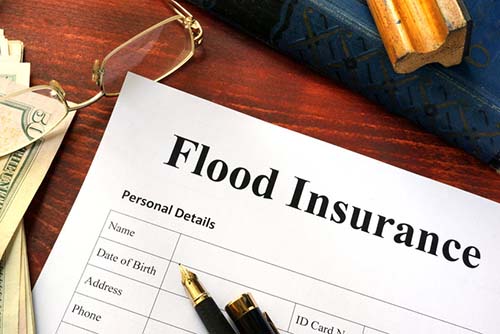Flood Insurance
|
Flood Insurance is required by lenders when your property lies below the base flood elevation (BFE) also known as the one-hundred-year floodplain. Property above this is the elevation has less than a 1% chance of flooding annually. Nationally, twenty-five percent of all claims are filed by property owners, not in the 100-year floodplain.
FEMA Flood Zone MapWhen you do your due diligence, first determine in which flood zone your property is located. Use the FEMA Flood Zone Map to find the Flood Zone assigned to your property.
If you find your property is in any zone other than “X”, you are in a Flood Zone that requires flood insurance. How is it that one day your property can be out of the flood zone, but the next day it’s in the flood zone? Moving water erodes shorelines and over time this causes these bodies of water to change their course. So, FEMA continuously measures and redraws the maps using improved technology, to set the boundaries of the floodplain. Sometimes, the map will show that a portion of your property is in the flood zone beneath the BFE, while the building is above the BFE. In these instances, FEMA rules force the lender to require the borrower to have flood insurance in place. The exception applies when you can provide an elevation certificate from a surveyor that shows your building is above the BFE. |
|
Flood Insurance Quotes
This insurance is offered through the National Flood Insurance Program NFIP, a FEMA-sponsored program. Additionally, there are competitive markets that will compete for your business.
To get a quote, you will need to provide your insurance agent with:
To get a quote, you will need to provide your insurance agent with:
- Address of property
- Year built
- Square footage
- Number of stories
- Square footage of Basement / Crawl Space
- Lender flood insurance requirements
- Elevation certificate (for lower rates)
Removing the Requirement
If you have a mortgage on your property and the property is in the flood zone, you are required to have flood insurance. But there are a couple of strategies you can employ to remove the requirement.
- Pay off your mortgage. Without a mortgage, you are not required to have Flood Insurance. But, if your property floods, you have no mortgage, nor flood insurance, it’s on you to clean up your flood damage.
- Prove to FEMA that your building is above the BFE. This can be done through the Letter of Map Amendment (LOMA). To qualify, you will need to have a current elevation certificate provided by a licensed surveyor. Once you have the elevation certificate, you can engage FEMA directly, or hire a contractor who regularly works with FEMA to provide the necessary forms, etc. to remove your property from the floodplain. If successful, you will receive notice that you can present to your lender to remove the requirement.
FEMA
Federal Emergency Management Agency (FEMA) was established by Executive Order in 1979 by President Jimmy Carter for the purpose of disaster management and civil defense. The Agency was further defined in 1988 through the Disaster Relief and Emergency Assistance Amendments which further defined the Disaster Relief Act of 1974, renamed the Robert Stafford Act. FEMA is now its own agency under the U.S. Department of Homeland Security.
National Flood Insurance Program
The National Flood Insurance Program (NFIP) was instituted by Congress in 1968 to regulate floodplains and create different flood zones depending on the source of the potential flooding; Zones: A, E, X,
Depending on the Zone your property is in will determine the elevation required above Base Flood Elevation (BFE) for your building structure to be permitted for construction post FIRM or be recognized as not requiring Flood Insurance to meet your lender requirements.
Depending on the Zone your property is in will determine the elevation required above Base Flood Elevation (BFE) for your building structure to be permitted for construction post FIRM or be recognized as not requiring Flood Insurance to meet your lender requirements.

